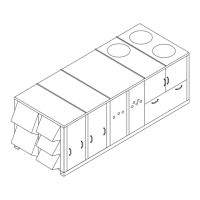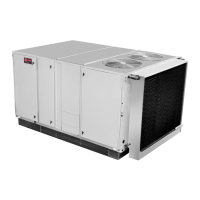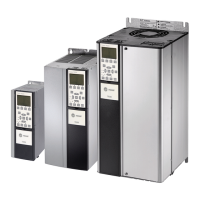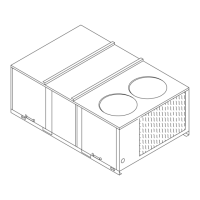RT-SVX34C-EN 11 5
Sequence of Operation
applications). The ECA modulates the economizer dampers from minimum position to fully open
based on a 1.5° F control point below either the space temperature setpoint for constant volume
applications or 1.5° F around the supply air temperature setpoint for variable air volume
applications. Refer to Figure 55, p. 114 for the Humidity versus Voltage Input Values.
If either or both the return air humidity sensor (RHS) or the return air sensor (RAS) fails, the
economizer will operate using the reference enthalpy setpoint perimeters.
Gas Heat Sequence Of Operation
When heating is required, the RTRM initiates the heating cycle through the ignition control module
(IGN). The IGN normally open contacts close to start the combustion blower motor (CBM) on high
speed. Next, the IGN control energizes the hot surface igniter (IP) for 45 seconds. After a preheat
period, the gas valve (GV) is energized for approximately 7 seconds. If the burner lights, the gas
valve remains energized. If the burner fails to ignite, the ignition module will attempt two retries
and then lock out if flame is not proven. The unit will attempt to ignite at 60 minute intervals until
the heating call is removed.
An IGN lockout due to flame loss can be reset by:
1. Open and close the main power disconnect switch.
2. Switch the MODE switch on the zone sensor to “Off” and then to the desired position (VAV units
– remove and reapply the mode input).
3. Allow the IGN to reset automatically after one hour.
When ignition takes place, the hot surface igniter (IP) is de-energized and functions as the flame
sensor.
Two Stage—If, after 60 seconds, the unit requires 1st stage heating only, the IGN will change the
combustion blower from high speed to low speed. If additional heating is required and first stage
heat has been operating for a minimum of 10 seconds, the IGN inducer relay will change the
combustion blower motor (CBM) to high speed, delivering second stage heat capacity.
Modulating—Units with modulating heat will fire the modulating bank first at high fire for 60
seconds. The unit will then modulate the heater to the necessary rate. If the modulating heat bank
cannot satisfy the zone needs alone, the second bank will come on and the modulating will find the
appropriate operating point.
Constant Volume (CV) unit fan operation
If the Fan selection switch is in the “AUTO” position for constant volume units, the RTRM will delay
starting the supply fan for 30 seconds to allow the heat exchanger to warm up. When the zone
temperature rises above the heating setpoint, the IGN control module will terminate the heat cycle.
The supply fan remains energized for an additional 90 seconds.
Variable Air Volume (VAV) unit fan operation (2 stage and modulating gas
heat)
During Unoccupied heating, Morning Warmup, and Daytime Warmup mode, the VFD or IGV must
be at 100%. Therefore, before the unit can heat, the VHR relay must have been energized for at least
6 minutes to ensure that the VAV boxes have driven to maximum. For example, 6 minutes after
a Daytime Warmup mode is initiated, the VFD / IGV output will go to 100% and then the heat cycle
will begin. The VHR relay is energized during Unoccupied mode, Morning Warmup mode, and
Daytime Warmup mode. This 6 minute delay before ig(next heading)
Variable Air Volume (VAV) unit fan operation (modulating gas heat only)
During Changeover Heat (LTB5-1 shorted to LTB5-2), the unit will heat to the Supply Air Heating
Setpoint +/- 7F. The VFD/IGV will modulate to maintain the Static Pressure Setpoint.

